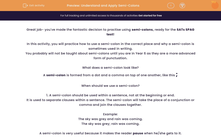Great job- you've made the fantastic decision to practise using semi-colons, ready for the SATs SPAG test!
In this activity, you will practise how to use a semi-colon in the correct place and why a semi-colon is sometimes used in writing.
You probably will not be taught about semi-colons until you are in Year 6 as they are a more advanced form of punctuation.
What does a semi-colon look like?
A semi-colon is formed from a dot and a comma on top of one another, like this ;
When should we use a semi-colon?
1. A semi-colon should be used within a sentence, not at the beginning or end.
It is used to separate main clauses (which make sense on their own) within a sentence. The semi-colon will take the place of a conjunction or full stop and join the main clauses together.
Example:
The sky was grey and rain was coming.
The sky was grey; rain was coming.
A semi-colon is very useful because it makes the reader pause when he/she gets to it. It also links two similar ideas. Both sides of the semi-colon should make sense on their own and a capital letter is not needed after it.
2. A semi-colon can also be used to separate items within a list if the list contains some internal commas. (This is more tricky!)
Example:
I have visited London, Brighton and Exeter in the South; and York, Newcastle and Leeds in the North.
Over to you now to have a go at some questions... Good luck!








